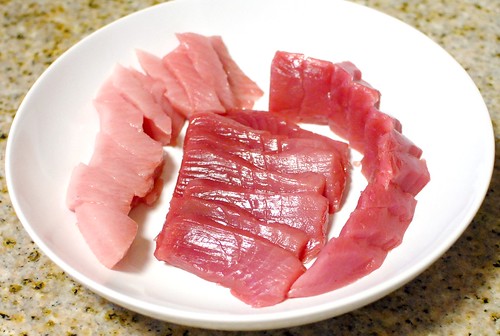Bluefin Tuna Sashimi
Dining date: 4/14/12
Last weekend, I was browsing my local Japanese Nijiya market when I stumbled upon an advertisement for a tuna filleting demonstration. It would be a prized bluefin tuna and the fish would be sold at the end of the demonstration! I knew tuna could be huge fish so I was curious to see what it would look like and how it was going to be broken down. Plus, I wanted to try some of the fish fresh off the cutting board.
Bluefin tuna is a poor choice in terms of sustainability (the Monterey Bay Aquarium assigns it an ‘Avoid’ rating) due to decades of over-fishing around the world. The primary consumer is Japan, where it’s considered a delicacy – particularly the fatty section of the belly, or toro. Given the depleting population and the fact that the fatty belly is a small fraction of the overall yield of the tuna, the toro is often one of the most expensive cuts in a sushi restaurant.
I dropped in to Nijiya just after 11am and an employee was well on his way to breaking down the fish. I’m not sure if he started with the whole fish (I was pretty early and his table wasn’t that large, so I don’t think he did), but it was clear that all of the parts were there from head to tail.
The tuna was effortlessly filleted, separating huge chunks of flesh from bone. Clearly, this guy had done this many times before. It was pretty cool to see the meat; a red to white gradient showed the level of fattiness from one side to the other. The deepest red color, and the leanest part of the fish, was akami. Often called maguro in restaurants, it’s the cheapest cut of bluefin. The rest of the flesh ranged from medium-fatty chutoro to the fattiest (and most expensive) of them all, otoro. The trimmings and other sections of the fish were sold too; I grabbed a small chunk of each of the three highest grades and took them home to eat.
I’ve never prepared sushi before, but I often purchase sashimi-grade fish to slice and eat. In short, sushi chefs make it look so damn easy to do but it’s really hard to slice it perfectly. In fact, I don’t even know what a perfect slice is supposed to be, but I did my best to cut against the grain and slice on a bias wherever possible (my pieces of fish were of varying shapes). The fattiness of the toro was evident when I was cutting it; my hands became oily just by touching the fish, and the knife sliced through like I was cutting a softened stick of butter. It wasn’t pretty, but I got everything sliced up and served it with a warm bowl of short grain rice and a soy sauce-wasabi mixture.
The fish was excellent and about as good as expected. I enjoyed the lean akami (on the right of the plate), which was still very tender and had good flavor. The chutoro (middle of plate) was even better, having a richer flavor while being even more silky and tender. Finally, the toro was expectantly rich and fatty with a texture that seemingly melted before it could be bit into. Like Japanese wagyu beef, it’s really best in small quantities because it’s just so incredibly rich and oily. But man, it is good stuff!
Dining on bluefin tuna (especially on the belly) is by no means an everyday occurrence, but it was fun to splurge on this a bit. Purchasing it from the market was a whole lot cheaper than a restaurant too (of course), with the whole plate above costing about $30…and it came with a show!













I swooooooooon….
Sometimes, I wish I lived in the apartment next door!
I wish you did too!